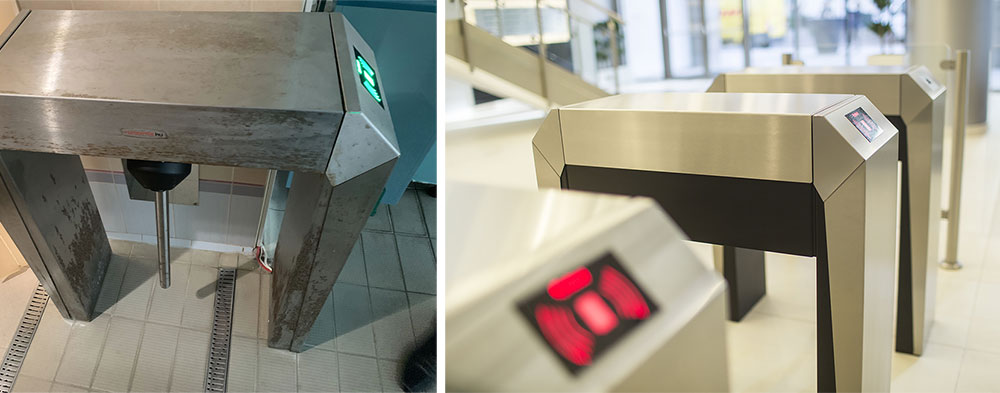In this article, we want to explain what the different components of access control systems are made of and, perhaps more importantly, how to clean them.
Let's start with the basic question: what is a modern access control device made of?
For the purposes of this article, access equipment is mainly gates and barriers, all of which are made of steel.
To be more precise: they are made either of carbon steel or of stainless steel. If the latter material is chosen by the company building the access system, there are also (to put it simply) two options: AISI 304 stainless steel and AISI 316 (although there are many more types, based on the composition of the steel, but for the purposes of this topic we will concentrate on these two main types).
The difference between the two is precisely the resistance of the steel, which differs due to the alloying materials and processes used in the production of the steel. For example, 304 steel generally has a higher Cr (Chromium) content, while 316 steel also contains Mo (Molybdenum), which 304 does not contain at all. It follows that 304 steel tools are good for use in environments where water, slightly contaminated water, food, acids up to 4.5 PH are present. This material is ideal in chlorine-free environments. In practice, it is used for construction, food vessels, tanks, piping, but also for dairy kettles.
316 is used in places where the equipment is subject to higher stress: chemical plants, paper industry, high chlorine content, or in highly acidic environments.
Thus, one of the two stainless steels mentioned above - 304 in the vast majority of cases - is used for access gates, barriers and railings. This type of steel can also be used in places where the conditions are not necessarily optimal (e.g. spas, near swimming pools), but where frequent and professional cleaning and maintenance is particularly important. Provided that they are properly maintained, cleaned and cared for, they will retain their aesthetic appearance for a long time. 316 steel is more resistant to environmental influences in these places, but the raw material and, for technological reasons, the machining of the steel is much more expensive and time-consuming, so their use is recommended only in particularly justified cases.
Can stainless steel rust?
Bad news: it can!
We'll show you a picture - the two access devices were installed at roughly the same time, with similar humidity and other conditions on a daily basis. One is regularly and well maintained, the other is not.
But how can this happen and how can it be avoided?
First of all, it is important to clarify what exactly is the difference between stainless steel (inox) and conventional or carbon steel:
Stainless steel contains at least 10.5% chromium. Stainless steel has a chromium oxide passive layer that adheres to the surface of the steel and prevents the formation of an iron oxide layer by preventing air and moisture from directly interacting with the steel. Rusting of these steels can only occur if this passive layer is damaged in some way.
Damage to the passive layer can also occur as a result of physical or chemical action. Examples of physical effects are surface scratching, drilling, grinding or welding. Chemical effects can affect steel in acidic or particularly strong alkaline environments.
Fortunately, in many cases it is not the steel that rusts, but the dirt on it - which makes it look as if the tool is rusted, but there is nothing wrong with it. With special cleaning products specifically for stainless steel and regular cleaning, these contaminants can be removed. There are also several inox cleaners that help the passive layer to regenerate. If these products are used regularly, stainless surfaces will remain decorative and rust-free for a very long time.
And in cases where the stainless steel does rust, the cause of the problem may be found in scratches and scratches, in addition to lack of maintenance. For example, if you hit a stainless surface with a non-stainless hammer and damage the passive layer, the damaged area will often start to rust. The same is the case if the surface is not properly maintained in an acidic, humid environment, where the acidic environment causes damage to the passive layer and reduces the resistance of the surface.
Prevention is therefore simple: these tools must be properly maintained:
- Keep it clean.
- Protect it from damage and scratches.
- Provide ventilation (the presence of oxygen helps the passive layer to regenerate).
- Depending on the environment, tools can become contaminated - cleaning should depend on this.
- Preferably use cleaning products specifically designed for inox, but temporarily use any non-scratch cleaner that does not contain chlorine.
- Cleaning should be followed by a thorough rinse with plenty of water for non-electrical equipment such as handrails.
- If mechanical cleaning is necessary, do not use any metal tools.
- Preferably do not use acid for cleaning, but if this is essential, use only phosphoric acid preparations.
- Please note that it is not advisable to use acidic cleaning products in the immediate vicinity of the appliance (e.g. cleaning tiles with hydrochloric acid), but if this is not possible, it is particularly important to clean the appliance thoroughly with inox cleaning products.
Our customers will receive detailed instructions from us on the cleaning and maintenance of access equipment, which can be passed on to the cleaning company/person. By following our advice, we can provide you with long-lasting devices.
If you are planning to install an access control system, please contact us.






